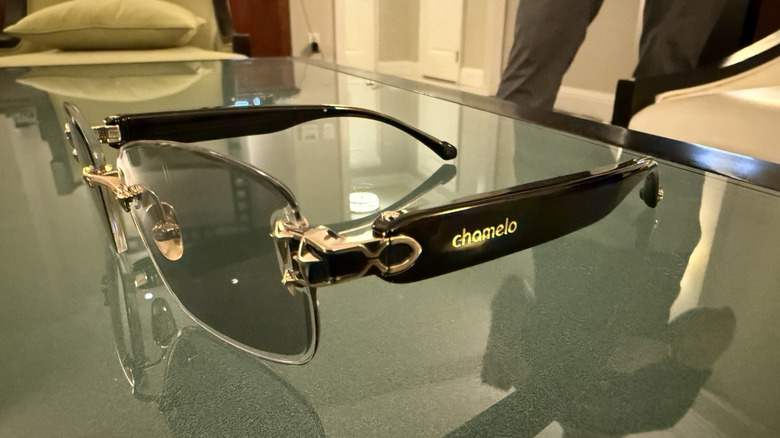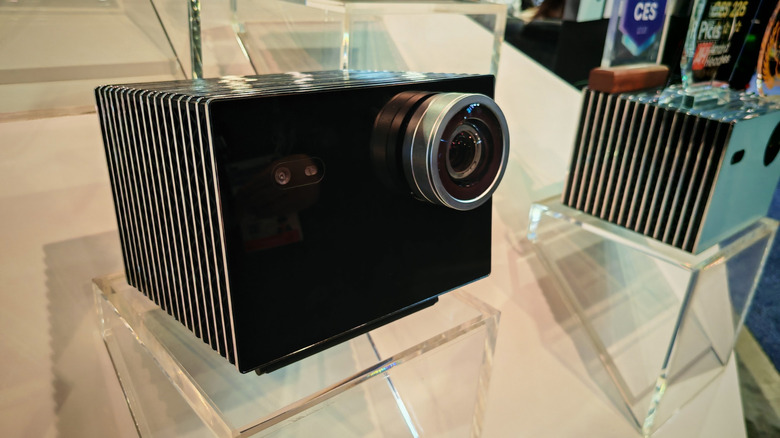CES 2025: The Best Of The Rest
CES 2025 is over, and we have returned to our respective abodes, but the echoes of technological magnificence still echo in our heads. In other words, we saw more than we could fill you in on over the last four days — that is assuming we wanted any amount of sleep. So, since we are home and relatively well-rested, we wanted to mention a few other products and companies that caught our eye while roaming the show floor.
So, let's take one more dip into the CES pool before we towel off and take a long, long, well-deserved nap. We have a new way to get around town, a new way to wire up your entertainment, and some tech that is on the wilder side of things. Once more into the breach we go; here's one last sampling of the Consumer Electronics Show's delights.
Segway enters the ebike space
The makers of Paul Blart's main form of transportation have a few new offerings at CES this year. The notable devices include two new e-bikes, the Xafari and the Xyber. They're both designed for different use-cases, with the Xafari being designed to be a sort of hybrid computer bike that can handle a bit of off-road action, and the Xyber being meant more as a throttle-only ride.
Both bikes have an array of features, accessible via app, including turn by turn navigation and music playback on the built-in LCD screen, auto-lock and unlock when you walk away from or come back to the bike, and powerful motors with long-lasting batteries. The Xyber has a range of up to 112 miles in a dual-battery configuration, while the Xafari has a range of up to 88 miles on a charge.
I had a chance to test out both bikes at an offsite location. Of the two, the Xafari rides more like an ebike with a torque sensor, adjustable seat height, and easy gear changes. The Xyber is more of a throttle-only affair, especially since the seat can't be adjusted. Tall people will have a hard time pedaling, but if they do, they'll find a cadence-sensor driven experience. Both bikes are available to preorder now, with the Xafari costing $2,399.99 and the Xyber commanding $2,999.99. Preorders start on Feb 2 on Segway's website.
Audio CU eliminates a pain point in home audio
Audio Cu by Fasetto is another super interesting piece of technology that showed up on the floor. This company uses proprietary technology to transmit audio signals through your power lines in your home. On its face, it seems like a simple concept, but in reality, the company holds over 200 patents in wireless communication that enable this. Here's how it works.
Your TV/receiver gets a transmitter and each of your speakers gets a receiver. You plug the TV into a transmitter that in turn gets plugged into an outlet. The receiver gets plugged into another outlet and then gets connected to the speakers. Through an app, you tell the transmitter which receiver gets which audio signal. From there, the audio is encoded, transmitted through your electrical wires, and decoded on the other end.
There is no loss of signal — Audio Cu had several systems on display and the audio was impressive with basically no latency. Further, the company had several appliances on display that cause interference on the line to show that there was no degradation of signal.
This is a really cool audio idea — losing the wires you would otherwise have to get to the other side of the room, but it's also pricey. A Dolby 5.1 system (Dolby certified, by the way) costs $2,700. I'm not positive that's worth eliminating a few wires by using...other wires, but some may disagree. Audio CU is focusing on installers at the moment, with consumer sales further out.
Chamelo makes transition lenses that don't suck
Last year, I met up with the founder of a company that was developing sunglasses that could darken with a touch of a button. Transition lenses, like those you'll find on Meta RayBans, will get darker in the sun, but usually slowly, and not terribly dark. Meanwhile, Chamelo is bringing two new sets of glasses to the market — Chamelo Prime and Shield — as well as teasing a third set of glasses, Music Shield. The cool part is that these glasses all use Chamelo's proprietary Eclipse tint-adjustable lenses, which use either a slider on the arm of the glasses or an automatic light sensor to adjust the light-blocking tint level basically instantaneously.
Also launching is Chamelo's Aura glasses, now with three customization options. You can change the arm color, add a prescription lens, and/or choose between making the lenses change color or the same tint adjustable style of lenses.
If I'm being honest, Chamelo's Eclipse technology is what all transition lenses need to be. It's instant, and it's a lot darker than even the latest transition lenses. Essilor Luxottica (parent company of Ray-Ban) should really be talking to these folks because this would honestly make the Ray-bans nearly perfect. For now, given a choice between one or the other, I'm probably choosing Chamelo for general use.
TCL's Ai Me is the latest example of an awful trend
During CES 2025, TCL unveiled Ai Me, an ai-powered companion robot that is supposed to entertain children, record life's little moments, and provide highlight reels of your family time. The product hasn't been announced for sale, but a working prototype was on display at the show.
Ai Me is part of one of tech's most ridiculous trends at the moment. Major companies like Amazon, Samsung, and now TCL seem to be convinced people are desperate for some kind of hyper-advanced Furby capable of spying on their families for fun.
Don't get us wrong, AI-powered robots can be very useful. But that's more a case of a vacuum cleaner avoiding pet mess, or Elon Musk's robotic fever dream actually manifesting into reality and loading the dishwasher for you. But a plastic potato with anime eyes that just sort of sits there is not one of those cases. Neither is a ball with an uninspiring projector taped to it or a trolley on wheels that can apparently bring you a beer as long as it doesn't have to open the fridge and grab the beer itself.
Oddly enough, when compared to Astro, Ballie, and other useless Ai bots, Ai Me may actually be the most functional. So, it wins that category. But just as shin kicking is a stupid sport, this is a stupid tech category, and you should feel pity for the man with the bleeding legs, even as he lifts his trophy.
Valerion launches a perfect projector for home cinema enthusiasts
Projectors had a very strong showing at CES, and they were all a little different, too. The Ultra Short Throw category had both a high-end example that snagged one of our best of awards, and a bargain option you can snag for less than $1,000. On the portable projector front, there's a little folding unit that can fit in your pocket and provide 90 minutes of entertainment when needed. Then there's Valerion, which may have just won when it comes to home cinemas.
Valerion's new model, the VisionMaster Max, can throw a 300-inch 4K image up onto a surface. To put that into layman's terms, it's likely larger than your living room wall. It also pumps out 3,000 lumens, which means you can easily use it in a brightly lit area — especially if it's throwing right onto a screen. A contrast ratio of 15000:1 and dynamic tone mapping means you get blacker, more noticeable, blacks from this high-end unit.
In terms of setup, it has the basics like auto keystone and more advanced features like dynamic iris technology, which adjusts the aperture based on the light in the room. A +/-105% offset means it's highly adjustable wherever you put it, and the lens is also capable of physically shifting over 50% vertically. The sound from the in-built speakers is also pretty solid. A UST projector may still be a better choice for a living room, but if you're planning a small, dedicated, cinema room and have just under $4,000 to spare, this is a hard projector to pass over.
Go all out with your gaming laptop
If you want to make a statement while gaming on a laptop, the MSI Titan 18 HX Dragon Edition Norse Myth might be what you need. The back of the screen has an image of a dragon etched into the metal, as you'll notice if you ever feel one, and that decoration continues on the other side too. Roughly where your palms rest while writing is a clear cover with a 3D-printed coin underneath. You can't really tell the coin is 3D printed, and it looks quite metallic while lit up in its little hole.
Underneath the admittedly pretty exterior, you'll find the same contents as any other Titan 18 HX. That's not a bad thing — in fact, a brand new 50-series GPU (the laptop version of a 5090 in this case), an Intel Core Arrow Lake processor, and an advanced cooling system makes this one of the most advanced gaming laptops on the market.
This is a limited edition laptop, so only a few hundred may roll off the production line in the end. Although it has enough under the hood to run everything that's going to be released in the next few years, you may be concerned about splashing out extra on a statement piece that will ultimately be obsolete one day. Pricing hasn't been released yet, but we were told it would cost "around $500" more than the standard Titan 18 HX when we asked. If that holds true, then it may just be worth it for the looks it will get at cafes and gaming meetups.






